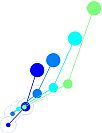Flexibility in an ever-changing world is key to survival and patch foraging decisions represent a natural example of this. Animals choose between exploiting local resources or leaving to explore potentially superior places (exploitation vs exploration). We developed an ethologically grounded olfactory patch foraging task to study flexible decision-making in head-fixed mice. Thirsty mice forage for clustered and depleting water reward patches on a closed-loop multi-sensory virtual track. Patches are defined by visual stimuli and reward sites within patches by olfactory cues (one type per patch). Naive mice acquire the task within 5 sessions. We show that the short acquisition time and minimal behavioral shaping allow mice to maintain behavioral flexibility and adopt distinct strategies as task parameters change within single sessions. We also probed behavior under different reward depletion rules using distinct odor patches that share the same rate but with different initial values. When rewards deplete in probability, a single leaving threshold was observed across patches (n = 12 mice), potentially indicating that mice make local patch leaving decisions that are sensitive to global reward statistics. To further prove this, we manipulated the environment patch statistics to create higher reward rate environments and lower reward rate ones. Mice adapted their local strategies to incorporate the changes in global rate in ways compatible with optimal foraging theory. Lastly, we modified the cost of travelling by independently modulating the cost (increasing or decreasing the friction of the wheel) and time (manipulating the distance between patches). We discuss our findings regarding predictions of Marginal Value Theorem as well as other alternative models. Future work will examine multi-regional neural dynamics underlying this behavior.

 PDF version
PDF version
